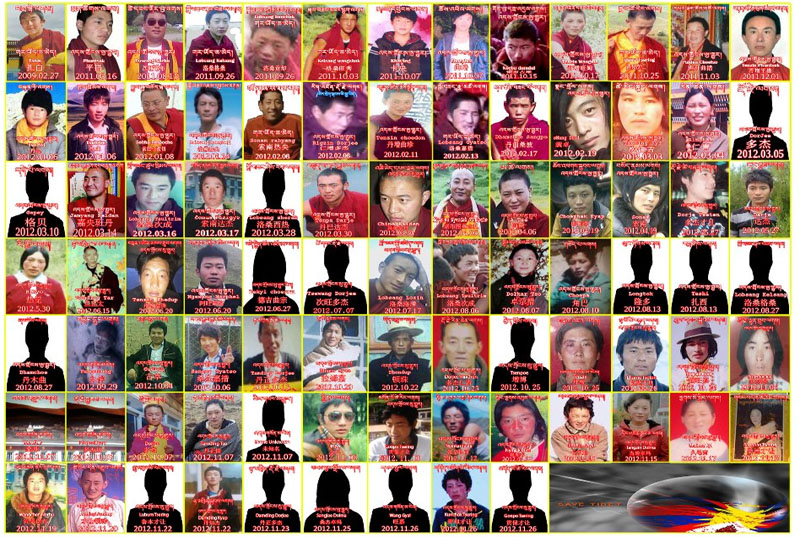AFP

Cockroach farmer Li Bingcai eating an exuvial roach at his farm in Yibin, China's southwestern Sichuan province.
Cockroach farm in China
As farmer Li Bingcai opened the door to his cockroach farm in southwest China, an insect the size of a dart flew into his face.
Picking the critter off his forehead, he tossed it back into the dark room where some 10 million more of its kind scurried around, housed in wooden frames perched on shelves.
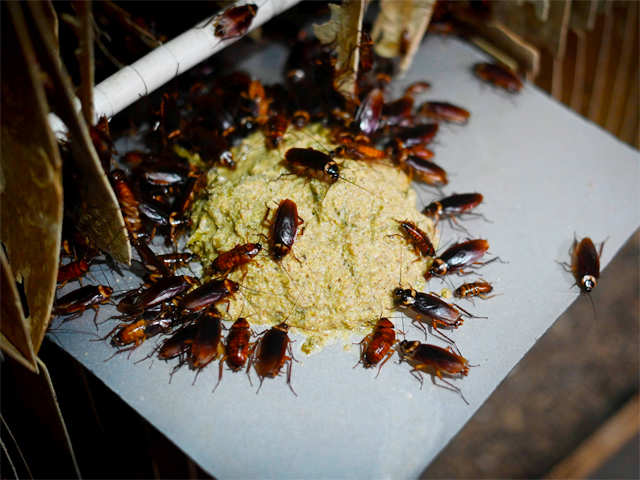
Cockroaches eating feed at a roach farm in Yibin, China's southwestern Sichuan province.
Breeding cockroaches
The six-legged creatures may be a bugbear for most, but Li and other breeders in China are turning them into a niche business.
Some sell cockroaches for medicinal purposes, as animal feed or to get rid of food waste.
Li breeds them for something else: food for human consumption.

A dish of cockroaches at a restaurant in Yibin, China's southwestern Sichuan province.
Food for human consumption
A restaurant down the road from his small facility fries them up in famously spicy Sichuan sauce for the gutsier eaters.
"People don't believe how good it is until they try some," Li told, putting a live one into his mouth as others crawled all over the place and people visiting.
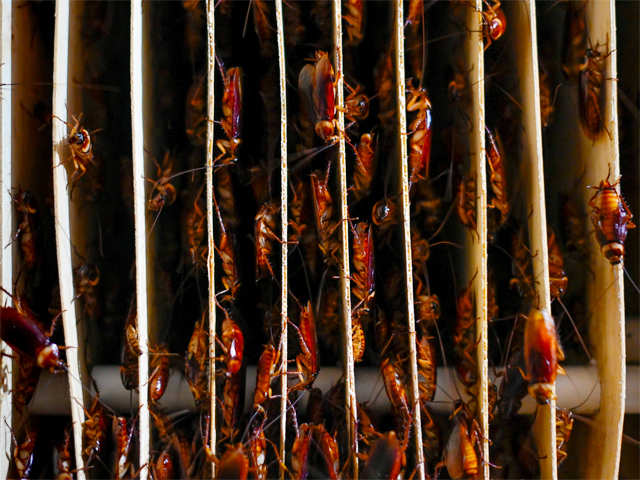
Roaches at a cockroach farm in Yibin, China's southwestern Sichuan province.

A dish of cockroaches at a restaurant in Yibin, China's southwestern Sichuan province.
Food for human consumption
A restaurant down the road from his small facility fries them up in famously spicy Sichuan sauce for the gutsier eaters.
"People don't believe how good it is until they try some," Li told, putting a live one into his mouth as others crawled all over the place and people visiting.

Roaches at a cockroach farm in Yibin, China's southwestern Sichuan province.
Cures ailments
Known colloquially as American cockroaches, the Periplaneta americana is one of the largest species and are consumed for a variety of ailments: stomach ulcers, respiratory tract problems, and even simply as a tonic.
"The greatest effect of cockroaches are that they have great immunity, which is why humans will absorb its benefits after eating them," Li said, noting that in China cockroaches are dubbed "Little Strong" because they can live for days even after being cut in half.
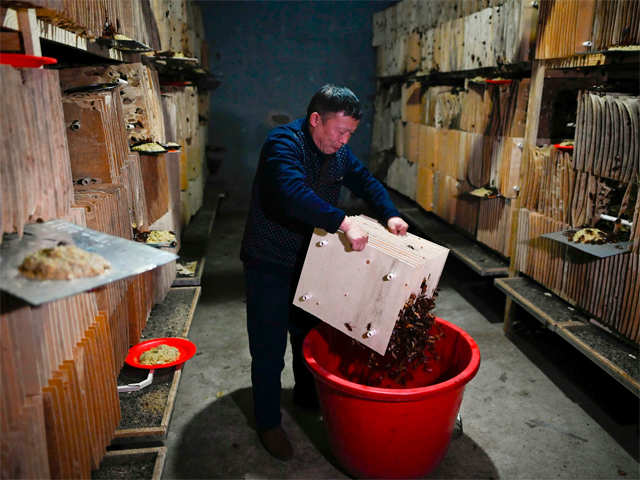
Cockroach farmer Li Bingcai harvesting roaches at his farm in Yibin, China's southwestern Sichuan province.
Security
Tucked at the edge of bamboo-covered mountains in Yibin, Li's facility is a nondescript single-storey former farmhouse surrounded by crop fields and livestock farms.
Tucked at the edge of bamboo-covered mountains in Yibin, Li's facility is a nondescript single-storey former farmhouse surrounded by crop fields and livestock farms.
The breeding area is roughly the size of a badminton court, with windows sealed off with netting to prevent any great escapes.
Security is paramount: In 2013, some one million cockroaches escaped a farm in eastern Jiangsu province roamed free after their greenhouse was destroyed.
Li's cockroaches live between the spaces of square wooden frames that are held together by pipes and stored in racks lining two rooms.
Security is paramount: In 2013, some one million cockroaches escaped a farm in eastern Jiangsu province roamed free after their greenhouse was destroyed.
Li's cockroaches live between the spaces of square wooden frames that are held together by pipes and stored in racks lining two rooms.
The place is kept warm and humid, leaving a smell reminiscent of damp clothes.

Cockroach farmer Li Bingcai holding up roach larvae at his farm in Yibin, China's southwestern Sichuan province.
Feeding time
Feeding time causes a frenzy -- as Li heaps a mix of ground corn, fruit and vegetable peelings on small trays, the insects suddenly swarm the platforms, crawling over each other.
"We breed them in a hygienic environment. They eat proper food -- nothing synthetic," he said.
Every three months, Li harvests the cockroaches to keep the population under control by dropping some into a vat of boiling water before dehydrating the carcasses.
Last year, he sold one tonne of dried cockroaches to a pharmaceutical factory for nearly 90,000 yuan ($13,500).
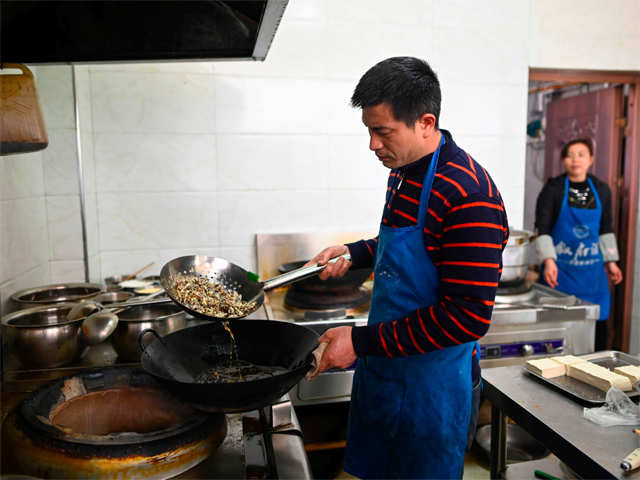
A cook frying cockroaches at a restaurant in Yibin, China's southwestern Sichuan province.

Cockroach farmer Li Bingcai holding up roach larvae at his farm in Yibin, China's southwestern Sichuan province.
Feeding time
Feeding time causes a frenzy -- as Li heaps a mix of ground corn, fruit and vegetable peelings on small trays, the insects suddenly swarm the platforms, crawling over each other.
"We breed them in a hygienic environment. They eat proper food -- nothing synthetic," he said.
Every three months, Li harvests the cockroaches to keep the population under control by dropping some into a vat of boiling water before dehydrating the carcasses.
Last year, he sold one tonne of dried cockroaches to a pharmaceutical factory for nearly 90,000 yuan ($13,500).

A cook frying cockroaches at a restaurant in Yibin, China's southwestern Sichuan province.
Caution
Li's main source of income is from selling the insects directly to farms or medicine factories, and this is supplemented by an online shop his daughter helped set up.
Li's main source of income is from selling the insects directly to farms or medicine factories, and this is supplemented by an online shop his daughter helped set up.
Half-a-kilo (1.1 pounds) of whole dehydrated insects retail for between 100 and 600 yuan ($15-$90).
The bugs have detoxifying properties and can act as a diuretic.
The bugs have detoxifying properties and can act as a diuretic.
It is also effective for relieving sore throat, tonsillitis, (liver) cirrhosis and fluid build-up.
But other Chinese medicine experts caution that a poorly regulated industry with a low barrier of entry could result in adverse effects.
But other Chinese medicine experts caution that a poorly regulated industry with a low barrier of entry could result in adverse effects.

 Drugkho, a Tibetan youth seen in these undated photos, set himself on fire to protest China’s repressive policy in Tibet near the Ngaba District’s security office, Sichuan Province, Dec. 8, 2018.
Drugkho, a Tibetan youth seen in these undated photos, set himself on fire to protest China’s repressive policy in Tibet near the Ngaba District’s security office, Sichuan Province, Dec. 8, 2018.

